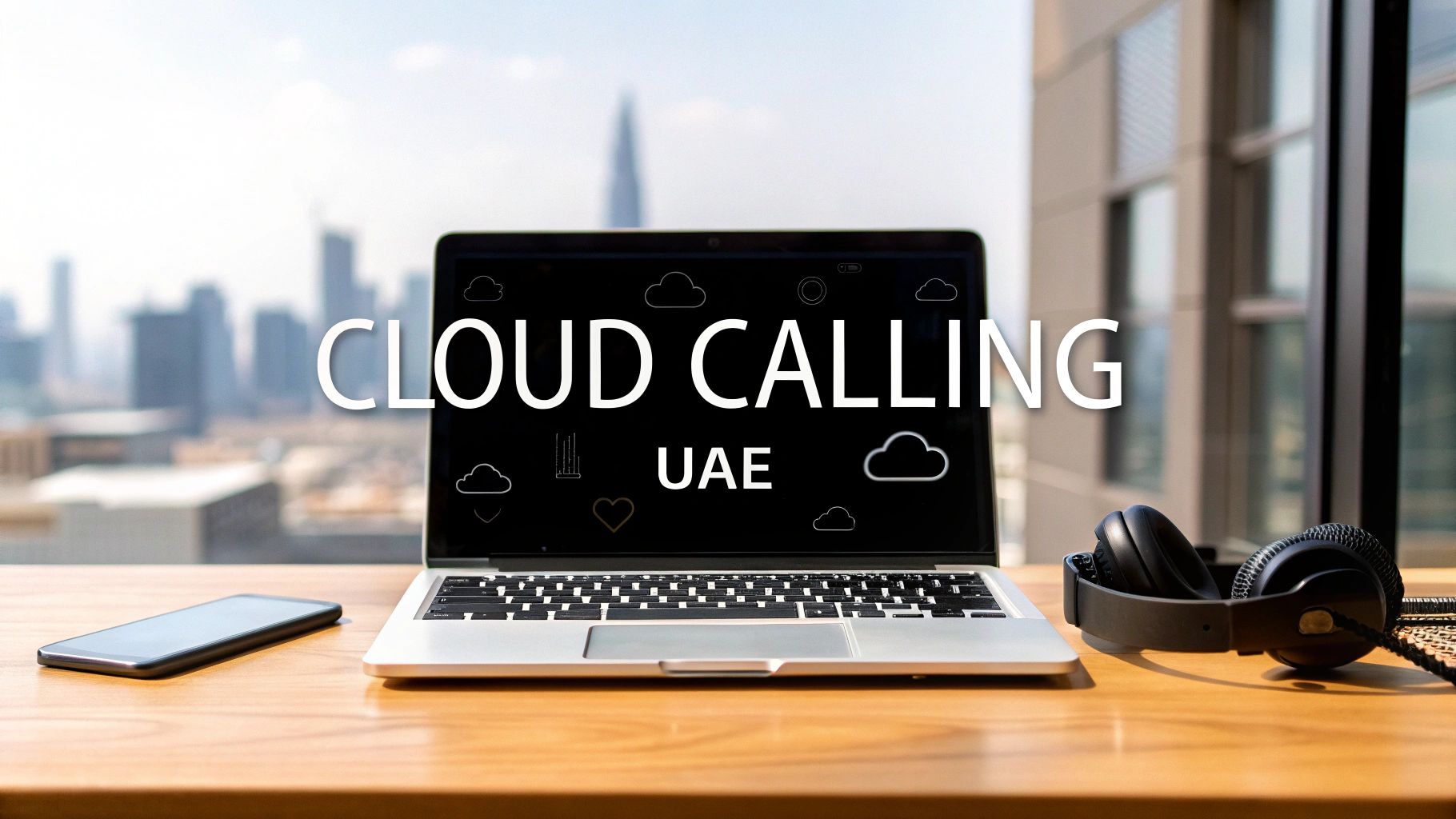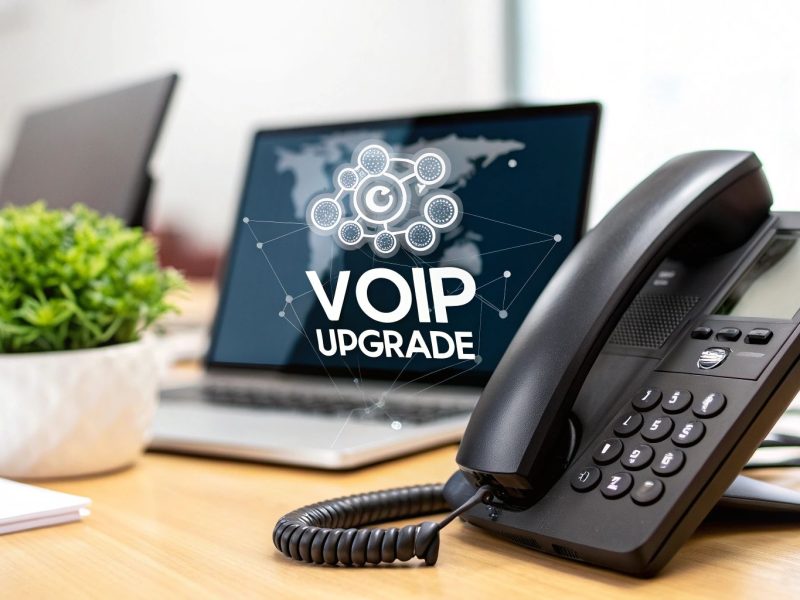For businesses in the UAE, the way we communicate is undergoing a massive change. We're moving away from the old, hardware-heavy phone systems of the past and embracing a much more flexible, internet-based approach. Simply put, cloud calling lets you run your entire business phone system online. This means no more clunky equipment in a server room and the freedom for your team to connect from anywhere, on any device—a critical advantage in the UAE's dynamic market.
The Future of Business Calls in the UAE

Think about the traditional office phone system, the Private Branch Exchange (PBX). It's like having a private library—a big, stationary collection of books that’s stuck in one building. Maintaining it is expensive, updating it is a headache, and you can only access it if you're physically there. This model served its purpose for years, but it just can't keep up with how we work today.
Now, compare that to cloud calling in the UAE. It's more like having a massive digital library right on your phone or laptop. Your entire communications setup is hosted securely in the cloud by a specialised provider. As long as you have an internet connection, you're in business. This virtual model is completely reshaping how companies in Dubai, Abu Dhabi, and across the Emirates connect with their customers and how their own teams collaborate.
A Strategic Move Beyond Technology
Switching to a cloud-based phone system is far more than a simple tech upgrade; it’s a smart business move. Today's customers expect to reach you easily, and often across several different channels. Cloud calling is the backbone that makes this kind of responsive, agile communication possible.
This shift directly supports key business goals by:
- Enabling a Hybrid Workforce: Your team can use their official business number on their laptop, desk phone, or a mobile app, whether they're at the office, at home, or on the road.
- Meeting New Customer Expectations: These systems often integrate with other business tools, creating a unified customer experience that leads to faster, more personalised service.
- Driving Operational Efficiency: You get to offload the headache of managing and maintaining physical hardware. This frees up your IT team to work on projects that actually grow the business.
This move to the cloud isn't just about phones; it's about building a more integrated and intelligent way to communicate. When you centralise call management, you can start gathering useful data, seeing call patterns, and really fine-tuning your customer service strategy.
The Rise of Intelligent Communication
The next frontier is making these communication platforms even smarter. We're seeing advanced technologies merge with cloud calling systems to deliver a huge leap in efficiency. For example, integrating tools like Voice AI Agents can automate routine queries, route calls to the right person instantly, and even give real-time support to your human agents.
This push towards intelligent, unified communications is where the market is headed. If you’re looking to build a truly robust system that seamlessly handles voice, chat, email, and social media, then getting to grips with an omni-channel contact centre is a must. This integrated approach, which we explore in our guide to Xcally UAE solutions, is truly the future of customer engagement in the region.
How Does Cloud Calling Actually Work?
Let's pull back the curtain on cloud calling in the UAE and see how it all works, without getting bogged down in technical jargon. The engine driving this technology is Voice over Internet Protocol, or VoIP. It might sound complex, but the idea is simple: your voice is converted into digital information and sent across the internet, just like an email or a video stream.
Think of it like this: a traditional phone system is a bit like a railway network. It’s built on a fixed, physical infrastructure of copper wires and exchanges. It gets you from A to B, but it’s rigid. Cloud calling, on the other hand, is like using a navigation app on your smartphone. It uses the existing, sprawling network of the internet to find the best, most efficient route, freeing you from the limitations of physical hardware.
This shift from physical wires to digital data is what gives businesses such incredible flexibility. And the best part? You only need three core elements working together to make it happen.
The Three Pillars of Cloud Communication
For any business in the UAE, getting started with cloud calling is remarkably simple. It all comes down to your provider, your internet connection, and your devices.
-
The Cloud Host (Your Provider): This is the company that runs your entire phone system from their own secure data centres. They manage all the complex servers, software, and maintenance, so you don’t have to. Essentially, they are the power station for your communications; you just plug in and get to work.
-
A Stable Internet Connection: This is the digital highway your voice travels on. A reliable, high-speed business internet connection is non-negotiable. It’s what ensures your calls are crystal-clear, without any frustrating lag or dropped connections.
-
Your Endpoints (Your Devices): These are simply the tools your team uses to make and receive calls. The real beauty of cloud calling lies in the sheer variety of options you have here.
You can mix and match devices to fit how your team actually works. Your accounts team in the office might prefer a familiar IP desk phone. Your sales team, working remotely from across Dubai, can use a softphone app right on their laptops. Meanwhile, your engineers out in the field can stay connected using a mobile app on their smartphones—all while using the same official company number.
"The magic of cloud calling is its ability to separate your phone number from a physical line. Your business identity is no longer tied to a specific desk or location; it follows your employees wherever they work, ensuring a consistent and professional presence for your customers."
The Journey of a Cloud Call
So, what’s happening behind the scenes when you actually pick up the phone?
Imagine an employee in your Abu Dhabi office dials a client's number on their IP phone. The moment they speak, their voice is captured and instantly broken down into small digital packets of data. These packets are then encrypted for security and sent over your office's internet connection to your provider's cloud platform.
From there, the provider's system intelligently routes the call onto the public telephone network, connecting to the client’s phone just like any other call. This entire journey takes just milliseconds. The result is a seamless conversation that sounds and feels exactly like a traditional one, but it’s backed by a host of powerful features running silently in the background.
The reliability of this system in the UAE is rock-solid, thanks to massive local investment in digital infrastructure. The UAE's data centre market, currently valued at around USD 1.26 billion, is expected to skyrocket to USD 3.33 billion by 2030. This growth is fuelled by global players like Microsoft and Amazon Web Services expanding their local presence. You can read more about the UAE's data centre expansion and its impact on cloud services. This robust foundation means UAE businesses can adopt these solutions with complete confidence.
Business Advantages of Switching to Cloud Calling
Making the switch to cloud calling in the UAE is more than just a tech upgrade; it’s a strategic move that delivers real, measurable benefits to your bottom line. When you shift your communications to the cloud, you’re not just replacing an old phone system. You’re unlocking a new standard of efficiency, flexibility, and customer engagement that impacts every part of your organisation, from finance to daily operations.
Say Goodbye to High Costs and Hello to Smart Spending
One of the first things you'll notice is the financial relief. Traditional on-premise PBX systems are notorious for their hefty upfront hardware costs, not to mention the ongoing expenses for maintenance, repairs, and the specialised IT staff needed to keep them running. Cloud calling turns this model on its head.
With a cloud system, you move away from a large, one-time capital expense (CapEx) and into a predictable operational expense (OpEx). It’s a simple monthly subscription per user, which typically covers maintenance, software updates, and support. This makes budgeting a whole lot easier and more transparent.
This shift has a direct impact on your ability to reduce call center costs. Instead of sinking capital into hardware that quickly becomes outdated, you can channel those funds back into what really matters—growing your business.
To give you a clearer picture, let's compare the two side-by-side.
Traditional PBX vs Cloud Calling: A Head-to-Head Comparison
This table breaks down the fundamental differences between sticking with an old-school phone system and moving to a modern cloud solution. The advantages quickly become clear.
| Feature | Traditional PBX System | Cloud Calling Solution |
|---|---|---|
| Initial Cost | High (Requires significant hardware purchase) | Low (No on-site hardware needed) |
| Maintenance | Requires specialised IT staff and ongoing service costs | Managed entirely by the provider, included in the subscription |
| Scalability | Rigid and expensive to scale up or down | Highly flexible; add or remove users instantly with a few clicks |
| Location | Tied to a physical office location | Accessible from anywhere with an internet connection |
| Feature Updates | Manual, often requires new hardware or costly upgrades | Automatic and frequent, delivered seamlessly through the cloud |
| Disaster Recovery | Complex and often requires a duplicate system | Built-in redundancy; calls can be rerouted automatically |
| Advanced Features | Limited or available as expensive add-ons | Includes CRM integration, analytics, and call routing as standard |
| Workforce Flexibility | Poorly supports remote or mobile work | Designed for hybrid and remote teams, offering seamless connectivity |
As you can see, the cloud model isn't just a different way to handle calls—it's a fundamentally more agile and cost-effective approach to business communications.
Empowering a Truly Flexible Workforce
The modern UAE workforce is no longer confined to a single office. Your teams are mobile, distributed, and need tools that can keep up. Cloud calling is the perfect platform for this new era of work, creating a single, unified communications hub for everyone, no matter where they are.
- Geographic Freedom: An employee at your Dubai headquarters, a remote team member in Abu Dhabi, and a sales executive travelling abroad can all use the same business phone number across their preferred devices.
- Device Flexibility: Calls can be answered on a desk phone, a laptop softphone, or a smartphone app. This ensures your team is always connected and projecting a professional, unified front.
- Enhanced Collaboration: It’s about more than just calls. Integrated features like presence status, team chat, and simple call transfers make a distributed team feel like they're working side-by-side in the same room.

As the image suggests, effectively connecting your team—a core strength of cloud calling—is a direct path to celebrating major business wins.
Gaining Unmatched Scalability and Advanced Features
Your business grows and changes. Your phone system should be able to adapt without causing a headache. Cloud calling offers incredible agility, letting you scale your service up or down on demand.
Need to add a new user for a seasonal project? They can be set up and making calls in minutes. If a team downsizes, you simply adjust your subscription. This pay-as-you-go model means you only ever pay for what you actually use, which is a world away from the rigid, often oversized capacity of an on-premise system.
But it’s not just about size. Cloud calling in the UAE also gives you access to a powerful suite of features that used to be reserved for giant corporations with deep pockets. These tools can have a massive impact on both team productivity and the customer experience.
- Intelligent Call Routing: Set up rules to automatically send incoming calls to the right person or department based on the time of day, caller ID, or choices made in an IVR menu.
- CRM Integration: Link your phone system directly to platforms like Salesforce or HubSpot. This can trigger screen-pops with customer data on incoming calls and automatically log every interaction, leading to smarter, more personal conversations.
- Advanced Analytics: Get a clear view of your communications with detailed dashboards and reports. Track call volumes, monitor agent performance, and identify peak times to optimise staffing.
This shift is happening across the UAE, with businesses in e-commerce, healthcare, and finance leading the charge. They are moving away from legacy systems to meet the modern customer’s expectation for fast, intelligent service. This is all part of a larger trend toward creating an exceptional customer journey, which you can read more about by exploring the https://cloud-call-center.ae/2025/05/48/top-cloud-contact-center-solutions-for-2025-enhance-customer-service/.
Navigating UAE Telecom Regulations
When you're looking to bring cloud calling into your UAE business, thinking about the local regulations isn't just a box-ticking exercise. It’s absolutely fundamental. Get it wrong, and you risk not only hefty fines but also losing the trust of your customers before you’ve even earned it.
In the United Arab Emirates, the Telecommunications and Digital Government Regulatory Authority (TDRA) is the governing body for all things telecom. They set the rules of the road to ensure a fair, secure, and reliable communications network for everyone.
While these regulations might seem complex at first glance, they're really about creating a transparent and safe environment. The key is to partner with a provider who lives and breathes these rules. They'll be your guide, making sure your setup is compliant from day one.
The TDRA's framework has a direct impact on how you can make calls. For instance, you can't just start dialling out; all outbound business calls need a green light from the TDRA and must use locally registered phone numbers. This is all about transparency. Callers are also required to state who they are and why they are calling right at the start of the conversation. You can discover more about the specifics of UAE call regulations to keep your team on the right side of the law.
Key Compliance Pillars for Your Business
To operate legally and effectively, your business needs to focus on three core areas. Think of them as the foundation of your entire communications strategy.
-
Mandatory Local Caller ID: The TDRA insists that every business call you make must display a recognisable, locally registered UAE phone number. This simple rule is a powerful tool against "spoofing" and other deceptive tactics. More importantly, it dramatically increases your answer rates because customers see a familiar local number they can trust.
-
Using Approved Number Ranges: You can't just pick a number out of thin air. Your cloud calling provider must supply you with numbers that are officially allocated and registered for business use within the UAE. A compliant provider will handle this for you, ensuring every number you use is fully legitimate.
-
Adherence to Marketing and Call-Time Rules: There are strict guidelines on when and how your business can make unsolicited calls. Breaching these rules can have serious consequences. A good provider will help you configure your system to automatically respect "do-not-call" lists and time-of-day restrictions, protecting you from accidental violations.
Understanding Data Sovereignty
There's a critical concept you'll hear a lot about in the UAE: data sovereignty. At its heart, it's a simple rule with big implications. It means that sensitive business data, especially communications data, must be stored on servers physically located inside the UAE.
This isn't just a best practice; it's a legal requirement designed to protect national security and resident privacy. When vetting potential providers, one of the most important questions you can ask is: "Where will my call data and recordings be stored?"
If a provider uses data centres outside the UAE, they could be putting your business in a precarious legal position. Reputable providers will operate local data centres in places like Dubai or Abu Dhabi and have a clear policy on data residency. This gives you peace of mind that your sensitive information never leaves the country.
The Role of Your Provider in Ensuring Compliance
Honestly, choosing the right technology partner is more than half the battle. A truly knowledgeable provider doesn't just sell you a service; they act as your compliance guide. They build the regulations directly into their technology, making it easier for you to stay compliant.
This is particularly important when connecting your cloud system to the public network, which is often done using an Etisalat SIP Trunk. This connection has to be configured perfectly to meet all TDRA standards.
Your provider should proactively guarantee:
- Built-in Compliance: The platform should be designed from the ground up to follow TDRA rules.
- Clear Documentation: They should be able to easily provide you with proof of their licensing and compliance.
- Expert Guidance: Their team needs to be ready to answer your questions about the regulations and how they apply to your specific industry.
Ultimately, compliance with the rules for cloud calling in the UAE is a shared responsibility between you and your provider. By understanding the core requirements and choosing a partner with proven local expertise, you can protect your business, build stronger customer relationships, and get back to focusing on growth.
How to Choose the Right Cloud Calling Provider

Choosing a partner for cloud calling in the UAE is probably the most critical decision you'll make in this entire journey. The right provider feels like an extension of your own team—a strategic ally dedicated to keeping your communications sharp, secure, and reliable. But get it wrong, and you could be looking at dropped calls, compliance headaches, and a whole lot of frustration.
This isn't a choice to be made lightly. To help you navigate the options with confidence, we've put together a checklist based on our own experience. Use these points to vet potential providers and find a partner who truly gets what your business needs.
Start with Non-Negotiable Compliance
Before you even glance at a feature list or pricing table, your very first question must be about local regulations. In the UAE, this is the absolute starting line. Any potential provider must be fully compliant with the rules laid out by the Telecommunications and Digital Government Regulatory Authority (TDRA).
Don't just take their word for it. Ask for proof. They should be able to clearly articulate how their service guarantees the use of locally registered numbers and upholds all data sovereignty laws.
Remember, data sovereignty isn't a suggestion; it's a legal requirement. A serious provider must operate data centres physically located within the UAE. This is the only way to ensure your call recordings and customer data stay within the country, protecting you from major legal and security risks.
Scrutinise Technical Foundations
Once you've ticked the compliance box, it's time to pop the bonnet and look at the engine. A provider's technical infrastructure directly impacts the quality of every single call your business makes or receives.
- Data Centre Location and Quality: Ask exactly where their UAE data centres are. Proximity matters—it cuts down on latency, which is the key to crisp, clear conversations. It’s also a good sign if they partner with top-tier infrastructure providers like Microsoft Azure, as it shows a real commitment to stability.
- Carrier Connections: How do they plug into the local telecom networks? You're looking for providers with direct, established partnerships with major carriers like Etisalat and du. These direct links offer far better voice quality than services that bounce your calls through various international networks.
Compare Features and Integrations
Now for the interesting part: the features that will actually help your team work smarter. The trick is to avoid being dazzled by a long menu of functions you'll never touch. Focus on the tools that solve your specific problems. When weighing your options, it's useful to see how they stack up against other modern platforms, like the ones in this list of the Top 8 Small Business Phone Systems.
Here are a few key features to prioritise:
- CRM Integration: Can the system talk to your existing CRM, whether it’s Salesforce, HubSpot, or something else? This is essential for automatically logging calls and giving your team the customer information they need, right when they need it.
- Advanced Analytics: Does it provide a clear, detailed dashboard? You need to easily track metrics like call volumes, average wait times, and agent performance to make smart decisions about your operations.
- AI-Powered Capabilities: Look for modern tools that make a real difference, such as intelligent call routing, automated call transcriptions, and sentiment analysis. These aren't just buzzwords; they can significantly boost your team's efficiency and elevate the customer experience.
Evaluate Support and Service
When something goes wrong with your phone system—and eventually, it will—you need help from real people who are quick, knowledgeable, and understand the local context. This is an area where many international providers stumble.
Insist on local, Arabic-speaking support that’s available when you are. Your business doesn't clock off at 5 PM, and your provider's support team shouldn't either. A strong local presence is one of the best signs of a provider's commitment to the UAE market.
Finally, never commit to a service you haven't seen for yourself. Request a live, personalised demo. This is your chance to click around the interface, ask tough questions, and get a genuine feel for the platform. A proper demo is the final check that confirms you’ve found a partner you can rely on for the long haul.
Your Step-by-Step Implementation Plan
Switching to cloud calling in the UAE isn't about flipping a switch overnight. It’s a methodical journey. By breaking down the transition into a clear, manageable roadmap, you can ensure the move is smooth, successful, and doesn't disrupt your daily operations. This plan is your guide from the initial discovery phase to a fully operational system your team can use with confidence.
Think of it like building a custom home. You wouldn't start laying bricks without a detailed blueprint. This step-by-step approach is your blueprint for a seamless and rewarding communications upgrade.
Phase 1: Assess and Plan
The first, most crucial step is to look inward. Before you can choose the right solution, you need a crystal-clear picture of your current communications setup, its shortcomings, and what you hope to achieve in the future.
Start by auditing your existing infrastructure. How many users do you have? What are your current monthly costs? More importantly, what are the biggest pain points for your team and your customers? This deep dive gives you a solid baseline to measure success against later on.
With that data in hand, you can define your goals. Are you aiming to better support a hybrid workforce, slash operational costs, or finally integrate your phone system with your CRM? Setting these clear objectives is the compass that will guide your decisions throughout the entire process.
Phase 2: Select and Partner
Once your requirements are clearly defined, you're ready to start evaluating providers. This is a critical stage; the partner you choose will have a long-term impact on your business. Use the criteria we've already covered—TDRA compliance, local data centres, and dedicated support—as your non-negotiable checklist.
I always advise scheduling live demonstrations with your top two or three candidates. This is your chance to see the platform in action, get a feel for its user interface, and ask very specific questions about how it would handle your unique business workflows. Don't be afraid to ask for references from other UAE-based businesses, especially those in your industry.
"A provider's willingness to offer a personalised demo and connect you with existing clients speaks volumes about their confidence and transparency. It shifts the conversation from a sales pitch to a collaborative problem-solving session, which is the foundation of a strong partnership."
Phase 3: Configure and Customise
After you’ve chosen your provider, the real technical work begins. A good partner will assign a dedicated project manager to walk you through this stage, making sure the handover from your old system is as seamless as possible.
This phase involves several key technical steps:
- Number Porting: Your provider will handle the entire process of moving your existing business phone numbers to the new cloud platform. This is vital for ensuring you don't lose your established identity.
- User Profile Creation: You'll set up each team member with their own profile, assigning extensions and defining their access levels and permissions.
- Call Flow Design: This is where you get to be creative and customise how your business handles incoming calls. You can build intelligent call queues for different departments, set up professional auto-attendants (IVRs), and create smart rules for routing calls based on the time of day or even the caller's location.
Phase 4: Train and Roll Out
The final piece of the puzzle is empowering your team to actually use the new system. Your provider should offer comprehensive training sessions, tailored for both everyday users and your system administrators or supervisors. This is essential for making sure everyone is comfortable and confident with the new tools from day one.
I strongly recommend starting with a pilot group—maybe one department or a small, tech-savvy team—to test the system in a live environment. This allows you to gather real-world feedback and iron out any final kinks before the full company-wide launch.
Once the pilot is a success, you can confidently roll out the new cloud calling solution to your entire organisation, officially marking the completion of your migration.
Your Top Questions About Cloud Calling, Answered
Jumping into a new technology always comes with questions. Even after seeing the benefits, you probably have a few specific queries about how cloud calling would actually work for your business in the UAE.
Let's clear those up. Here are straightforward answers to the questions we hear most often from businesses just like yours.
Can I Keep My Existing Business Phone Numbers?
Yes, you absolutely can. This is a common concern, but rest assured, any credible provider in the UAE will handle this through a process called number porting.
It’s a standard procedure where your existing landline and mobile numbers are smoothly transferred to the new cloud system. This means no disruption for your customers, no need to update your marketing materials, and no lost calls. It's a critical part of ensuring a seamless switch.
What Kind of Internet Connection Do I Need?
Your internet connection is the backbone of your cloud calling system. For the best performance—think crystal-clear audio with no frustrating lag or jitter—a stable, business-grade internet connection is essential. We generally recommend fibre optic for the most reliable experience.
The specific bandwidth you need isn't a one-size-fits-all answer. It depends heavily on how many people will be on calls at the same time. A good provider won't just sell you a package; they’ll work with you to understand your team's calling habits and ensure your connection can comfortably handle the load.
Is Cloud Calling Secure for Business Communications?
This is a big one, and the answer is a firm yes—provided you choose a compliant, reputable partner. Security isn't just an add-on; it's built into the very fabric of enterprise-grade cloud calling platforms.
Leading solutions protect your conversations with powerful security features, including end-to-end encryption for all calls and strict compliance with local UAE data laws.
Top-tier providers use multiple layers of protection, from encrypting the voice data itself to housing it in secure data centres that meet stringent national regulations. Always ask a potential provider about their security protocols and certifications. Your business conversations are confidential, and your phone system should keep them that way.
How Does Cloud Calling Support Remote and Hybrid Teams?
Cloud calling was practically made for the way we work now. It frees your business phone number from a single device tethered to a desk. Your employees can make and receive calls on their official company number from anywhere, on any approved device.
Someone can be on a laptop softphone in a Dubai office, another can be using the mobile app from their home in Sharjah, and a manager could be travelling abroad. To the customer on the other end, it’s a seamless, professional experience. This unified approach is key to keeping your team connected and productive, no matter where they're working.
Are you ready to see how a modern communication platform can genuinely improve your business operations? Cloud Move offers specialised cloud calling and contact centre solutions that integrate with the tools you already use, backed by local expertise and 24/7 support.
Request your free, no-obligation demo today and discover a better way to connect.




